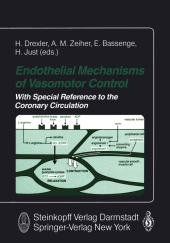 Neuerscheinungen 2012Stand: 2020-01-07 |
Schnellsuche
ISBN/Stichwort/Autor
|
Herderstraße 10
10625 Berlin
Tel.: 030 315 714 16
Fax 030 315 714 14
info@buchspektrum.de |

E. Bassenge, H. Drexler, H. Just, A. M. Zeiher
(Beteiligte)
Endothelial Mechanisms of Vasomotor Control
With special Reference to the Coronary Circulation
Herausgegeben von Drexler, H.; Zeiher, A.M.; Bassenge, E.; Just, H.
Softcover reprint of the original 1st ed. 1991. 2012. viii, 246 S. 352 pp. 244 mm
Verlag/Jahr: STEINKOPFF 2012
ISBN: 3-642-72463-9 (3642724639)
Neue ISBN: 978-3-642-72463-3 (9783642724633)
Preis und Lieferzeit: Bitte klicken
In recent years, we have witnessed a rapid expansion of our knowledge regarding the role of the endothelium in the control of vascular tone (and organ perfusion) in health and disease. Physiology, pharmacology, and molecular biology have uncovered a wealth of information on structure and function of this heretofore largely neglected "organ". Clinical medicine is now called upon to define the clinical significance of these observa tions that imply the mechanisms of blood coagulation, e.g., the interaction of throm bocytes with the endothelium, vasomotor control, and specifically, the regulation of smooth muscle tone with consequences for vascular resistance and conductance and organ blood flow. Finally, metabolism of lipids with the everlasting problem of athero sclerosis is an important aspect. In a second step, implications regarding the improvement of current therapeutic con cepts, as well as the development of new modalities of pharmacotherapy will have to be discussed. The topic addressed by the 1990 Gargellen Conference: Endothelial Mechanisms of Vasomotor Control, clearly is of interest for both basic scientists and clinicians. It has been the aim of the organizers, the Society for Cooperation in Medical Science (SCMS) with this and the previous symposia to foster and support both basic science and clinical research. Research in medicine today shows two major directions of development: on the one hand, increasing involvement of the basic sciences and their methodology. On the other hand, statistical validation of concepts and therapeutic strategies in large scale population-and multicenter-studies.
Basic Physiology of EDRF.- Cellular mechanisms controlling EDRF/NO formation in endothelial cells.- EDRF: nitrosylated compound or authentic nitric oxide.- Does EDRF/NO regulate its own release by increasing endothelial cyclic GMP?.- Molecular mechanisms of nitrovasodilator bioactivation.- Angiogenesis in the adult heart.- The endothelium in control of blood flow in vivo.- Endothelium and blood flow mediated vasomotion in the conscious dog.- Endothelium-mediated regulation of coronary tone.- Role of EDRF and endothelium in coronary vasomotor control.- Blood flow and optimal vascular topography: role of the endothelium.- Impaired tissue perfusion after inhibition of endothelium-derived nitric oxide.- Endothelial function in pathological conditions.- Endothelial dysfunction in myocardial ischemia and reperfusion: role of ogygen-derived free radicals.- Interactions between nitric oxide and prostacyclin in myocardial ischemia and endothelial cell cultures.- Effects of native and oxidized low-density lipoproteins on endothelium-dependent and endothelium-independent vasomotion.- Endothelium-dependent control of vascular tone: effects of age, hypertension and lipids.- Experimental induction of spasm, sudden progression of organic stenosis and intramural hemorrhage in the epicardial coronary arteries.- Endothelial dysfunction in hypercholesterolemia is corrected by L-arginine.- Endothelial function in the clinical setting.- Assessment of coronary vasomotor tone in humans.- Coronary vasomotion and coronary flow reserve during exercise.- Coronary hemodynamic determinants of epicardial artery vasomotor responses during sympathetic stimulation in humans.- Coronary vasospasm in humans: the role of atherosclerosis and of impaired endothelial vasodilator function.- Progression of coronary endothelial dysfunction in man and its potential clinical significance.- Response of coronary arteries to nitrates, the EDRF-donor SIN-1, and calcium antagonists.


